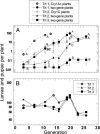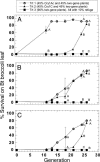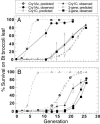Concurrent use of transgenic plants expressing a single and two Bacillus thuringiensis genes speeds insect adaptation to pyramided plants
- PMID: 15939892
- PMCID: PMC1150809
- DOI: 10.1073/pnas.0409324102
Concurrent use of transgenic plants expressing a single and two Bacillus thuringiensis genes speeds insect adaptation to pyramided plants
Abstract
Transgenic plants expressing insecticidal proteins from the bacterium Bacillus thuringiensis (Bt) were grown on over 13 million ha in the United States and 22.4 million ha worldwide in 2004. Preventing or slowing the evolution of resistance by insects ("resistance management") is critical for the sustainable use of Bt crops. Plants containing two dissimilar Bt toxin genes in the same plant ("pyramided") have the potential to delay insect resistance. However, the advantage of pyramided Bt plants for resistance management may be compromised if they share similar toxins with single-gene plants that are deployed simultaneously. We tested this hypothesis using a unique model system composed of broccoli plants transformed to express different Cry toxins (Cry1Ac, Cry1C, or both) and a synthetic population of the diamondback moth (Plutella xylostella) carrying genes for resistance to Cry1Ac and Cry1C at frequencies of approximately 0.10 and 0.34, respectively. After 24-26 generations of selection in the greenhouse, the concurrent use of one- and two-gene plants resulted in control failure of both types of Bt plants. When only two-gene plants were used in the selection, no or few insects survived on one- or two-gene Bt plants, indicating that concurrent use of transgenic plants expressing a single and two Bt genes will select for resistance to two-gene plants more rapidly than the use of two-gene plants alone. The results of this experiment agree with the predictions of a Mendelian deterministic simulation model and have important implications for the regulation and deployment of pyramided Bt plants.
Figures



References
-
- National Agriculture Statistics Service, U.S. Department of Agriculture (2004) http://usda.mannlib.cornell.edu/reports/nassr/field/pcp-bba/acrg0604.pdf.
-
- James, C. (2004) ISAAA Briefs (International Service for the Acquisition of Agro-Biotech Applications, Ithaca, NY), No. 32.
-
- Shelton, A. M., Zhao, J.-Z. & Roush, R. T. (2002) Annu. Rev. Entomol. 47, 845-881. - PubMed
-
- U.S. Environmental Protection Agency (2001) www.epa.gov/pesticides/biopesticides/pips/bt_brad.htm. - PubMed
-
- Tabashnik, B. E., Carrière, Y., Dennehy, T. J., Morin, S., Sisterson, M. S., Roush, R. T., Shelton, A. M. & Zhao, J.-Z. (2003) J. Econ. Entomol. 96, 1031-1038. - PubMed
Publication types
MeSH terms
Substances
LinkOut - more resources
Full Text Sources
Other Literature Sources

